Content
- Causes
- Symptoms
- Classification
- Diagnostics
- Treatment
- Pathogenetic method
- Symptomatic method
- Possible complications
- Dehydration of the body
- Prevention of dehydration
- Convulsions
- Bacteremia
- How to prevent illness
- Vaccination
- Forecast
- Rotavirus video
Rotavirus - acute infectious pathologycaused by rotavirus and affects the gastrointestinal tract. Pathology transmitted by tactile, contact pathology provokes the appearance of repeated vomiting, intestinal upset and a feverish state lasting for 5-7 days.
Due to weakened immunity, rotavirus infection often affects expectant mothers in the 1st, 2nd or 3rd trimester pregnancy, giving them not only unpleasant sensations, but also increasing the likelihood of intrauterine death child. In some cases, ignoring the disease can also cause the onset of premature birth or endanger the life of a young mother.
Causes
Rotavirus during pregnancy (1 trimester characterizes fatigue, nausea, or increased urination) in most cases, it is transmitted by contact through the interaction of a woman with a previously infected human.
Also, the expectant mother can get infected:
- when processing raw meat products, poultry or fish;
- when eating poorly peeled vegetables and fruits;
- when using tap, unboiled water for drinking;
- contacting during cleaning with infected feces or vomit.
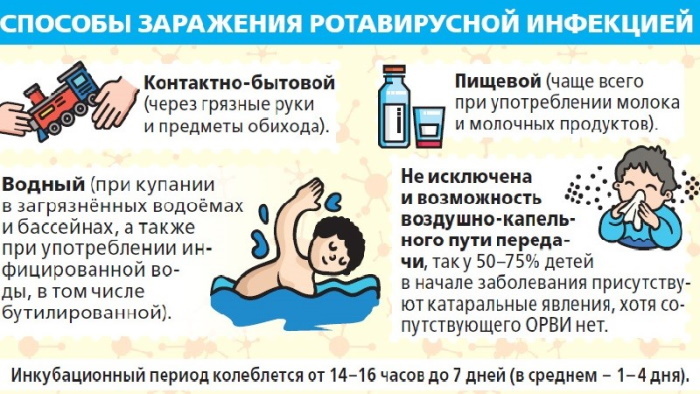
Most often, the disease is diagnosed in women in the 2nd trimester of pregnancy. During this period, the hormones of a young mother most strongly affect her digestive system, relaxing the intestinal muscles and lowering the body's resistance to pathogenic external influences.
Symptoms
Rotavirus during pregnancy (the 2nd trimester is characterized by the disappearance of nausea, improved appetite) is dangerous for young mothers at risk of developing spontaneous miscarriage occurring against the background of dehydration and intoxication organism.
Unpleasant symptoms of the disease occur in the expectant mother within 12 hours from the moment of infection and manifest themselves:
- high body temperature and fever;
- severe, repeated vomiting;
- sharp, cramping pains that occur in the upper abdomen;
- flatulence and rumbling in the intestines;
- watery diarrhea and frequent bowel movements (from 3 to 20 times a day).
In the early days of the disease, according to doctors, one can also observe the appearance of a moderate, short-term catarrhal syndrome, accompanied by nasal congestion, runny nose and cough. A temperature reaction (up to 38-39 ° C) can persist from 3 to 5 days and be complicated by intoxication of the body, which is characterized by lethargy, weakness and decreased appetite.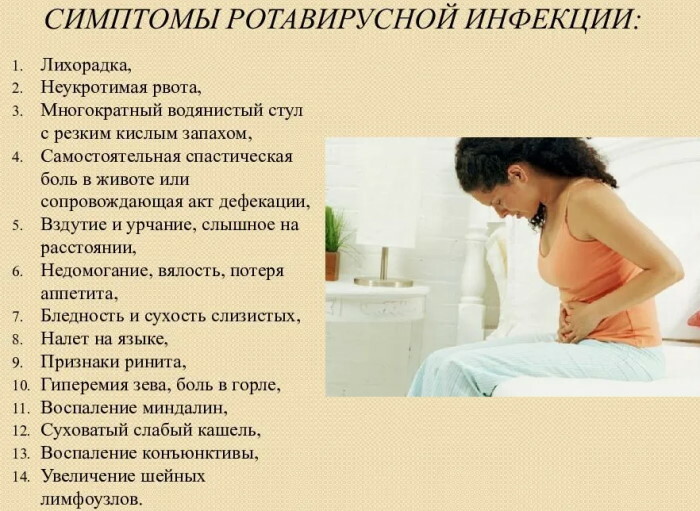
Unpleasant manifestations of the disease persist for 7-10 days, and over the next 2 weeks, a young mother is a carrier of the virus and can be infectious to her environment.
Classification
Rotavirus infection in medical practice is usually classified depending on the stage of severity of symptoms:
| The degree of the disease | How does it manifest |
| Mild severity | Pathology manifests itself:
|
| Moderate degree | Characterized by:
|
| Severe form of the disease | In addition to the classic symptoms of rotavirus, it is manifested by the development of a shock state:
|
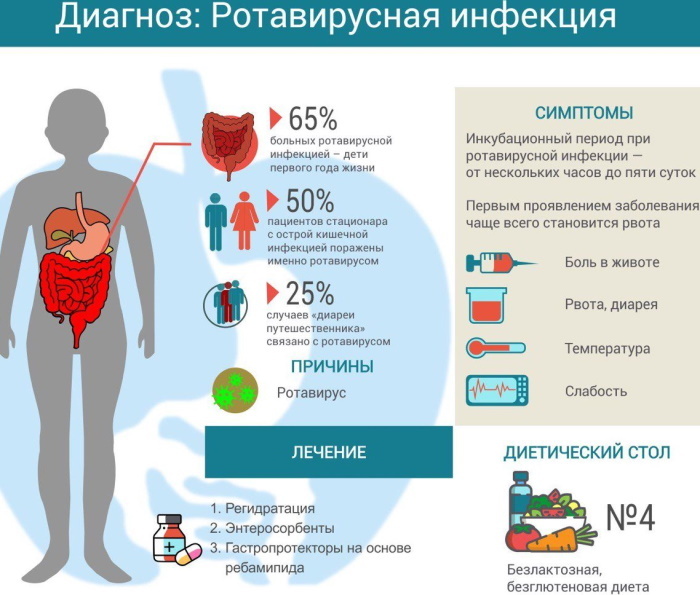 According to its clinical form, the disease, in accordance with the International Classification of Diseases (ICD-10), is subdivided into:
According to its clinical form, the disease, in accordance with the International Classification of Diseases (ICD-10), is subdivided into:
| Type of infection | Her characteristic |
| Typical rotavirus infection | Pathology begins suddenly and manifests itself as classic signs of infection occurring against the background of general intoxication of the body. |
| Atypical form of the disease | The disease can take place in 2 variants:
|
Diagnostics
Rotavirus during pregnancy (the 3rd trimester is characterized by the fact that the child moves more often) established by an infectious disease doctor based on the study of symptoms and after collecting a complete history diseases.
To clarify the diagnosis of a pregnant woman, a study of feces may be prescribed, which allows detecting the presence of rotavirus antigen and a serological blood test. After the diagnosis is established, a pregnant woman should definitely visit a gynecologist to correct the treatment prescribed by the infectious disease specialist and his subsequent monitoring of her condition and the course of pregnancy.
Treatment
Treatment of pathology during pregnancy is pathogenetic (aimed at treating the pathogenesis of the disease) and symptomatic (used to eliminate the symptoms of the disease) in nature.
Pathogenetic method
With the pathogenetic method, therapy is aimed at restoring the water-electrolyte balance in case of mild, moderate or severe dehydration. According to the recommendation of the World Health Organization (WHO), pregnant women faced with rotavirus should be prescribed water-salt solutions containing glucose and sodium, taken in equal proportions (1: 1), because:
- The use of fluids with a high glucose index increases diarrhea and decreases water absorption.
- The use of solutions with a high sodium content can cause the development of hypernatremia (an increase in the amount of sodium in the blood)

Oral rehydration therapy prescribed for the treatment of rotavirus is divided into:
| Treatment phase | Her characteristic |
| Rehydration phase of treatment | It is necessary to quickly replenish the lack of fluid in the body within 3-4 hours and allows the patient to return to a state prior to dehydration. |
| Maintenance phase | Continues to replenish the fluid lost by the body until vomiting and watery stools completely disappear. |
For oral rehydration, a pregnant woman is prescribed water-salt solutions ("Regidron", "Normohydron") used during the first 6-10 hours in an amount twice the weight loss caused by diarrhea.
In severe cases of the disease, rehydration therapy is administered intravenously.
Symptomatic method
Symptomatic therapy for rotavirus infection includes the use of probiotics, sorbents, and drugs that stop diarrhea.
The World Health Organization (WHO) recommends using the following to treat rotavirus infection in pregnant women:
- Probiotics containing bacteria Lactobacillus GG, Saccharomyces boulardii, Lactobacillus reuteri strain DSM 17938 ("Lactofiltrum", "Bifidumbacterin"), helping to reduce the duration and reduce the intensity of symptoms disease.
- Sorbents containing dioctahedral smectite, stabilizing the mucous barrier of the digestive system and possessing cleansing qualities necessary for the adsorption of bacteria, viruses and toxins.
- Antidiarrheal drugs based on loperamide, which slows down the propulsive intestinal motility. Due to its active qualities, Loperamide hydrochloride also increases the tone of the anal sphincter, increasing the retention time of feces and reducing the frequency of the urge to empty the bowels.

These pharmaceutical preparations are freely sold through pharmacy retail chains and do not harm the embryo even during the 3rd trimester of pregnancy. The treatment regimen and dosage of medicines are selected by a specialist individually, depending on the general condition of the woman.
Preparations based on diphenyloxalate, atropine or bismuth subsalicylate are prohibited for use in expectant mothers.
In addition to using drugs that are safe for a young mother and her baby during an illness, a woman needs:
- Eat fermented milk products (acidolact, bioyogurt, kefir) containing lactic acid bacteria necessary to restore intestinal microflora and prevent dysbiosis.
- Observe bed rest.
- Drink plenty of fluids.
If an upset stomach is complicated by constant vomiting of the expectant mother, experts recommend temporarily giving up solid food. When the condition improves, you can gradually introduce boiled rice and oatmeal into your diet. Doctors also strongly advise pregnant women to give up a variety of fruits and vegetables, salads and mashed potatoes for the duration of their illness.
Possible complications
Rotavirus during pregnancy (the 3rd trimester is characterized by the fact that the child has formed all the organs) is dangerous for a young mother by rapid dehydration of the body. Despite its infectious nature, the disease, according to experts, does not affect the development and formation of the embryo.
- In the early stages of pregnancy, the body of a young mother is weakened by hormonal changes and the onset of toxicosis, which, when a rotavirus infection appears and the development of a febrile state leads to rapid dehydration of the body and can provoke a miscarriage, fetal pathology, detachment placenta.
- In late pregnancy, a fully formed placenta protects the baby, but high temperature, intoxication and dehydration of the body of a young mother can provoke the onset premature birth.
Dehydration of the body
When dehydration begins, it is characteristic:
- the appearance of a strong feeling of thirst, accompanied by lethargy and drowsiness;
- sinking eyes;
- feeling of dry mouth;
- the appearance of small cracks in the tongue.
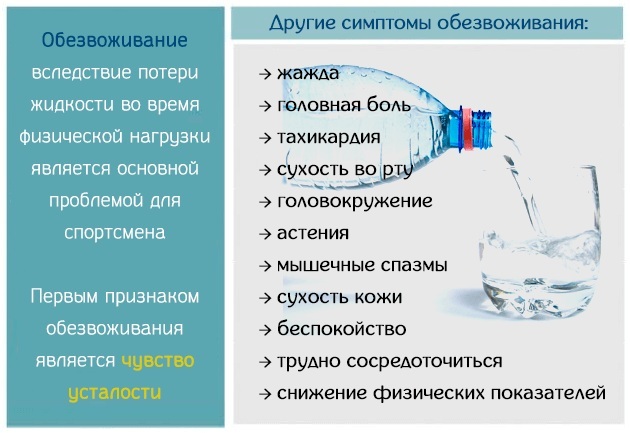
When these symptoms appear, a young mother needs to drink as much liquid as possible, and also use pharmacy rehydration solutions.
Vomiting with diarrhea that does not stop for 3-4 days is the basis for urgent hospitalization of a pregnant woman in a hospital for corrective therapy.
Hospitalization of a pregnant woman is necessary:
- with foggy consciousness;
- with incessant watery vomiting;
- with blackening of feces;
- when blood or pus appears in the urine;
- when the body temperature rises to 38-39 ° C, and does not decrease during the day.
Prevention of dehydration
When infected during pregnancy with rotavirus infection, experts advise expectant mothers to make efforts to prevent possible dehydration by:
- including bananas in your diet, excluding a possible decrease in the amount of electrolytes;
- drinking a lot of fluids (water with salt and sugar).
A woman can also prevent dehydration by using a diet that slows down indigestion and includes:
- boiled rice;
- cracker;
- raisins and dried apricots;
- bran;
- whole grain pasta.
At the same time, the expectant mother needs to give up foods that increase intestinal upset:
- various sweets;
- fatty, spicy and spicy dishes;
- dairy products;
- drinks containing caffeine.
Convulsions
The appearance of seizures arising against the background of rotavirus infection is characterized by short focal seizures that are observed within 2-3 days. The complication refers to neurological pathologies and is caused by a decrease in the amount of sodium in the blood of a young mother. Pathology, which is mild, has a favorable prognosis and stops with corrective treatment.
Bacteremia
If the febrile state persists during rotavirus infection for more than 3 days, bacteremia may develop due to the attachment of secondary bacterial infections.  The danger of this pathology is due to the fact that weakened by an infectious disease and long-term preservation feverish state, enterocytes are unable to timely prevent the activity of pathogenic pathogens that have entered the body of the expectant mother microorganisms.
The danger of this pathology is due to the fact that weakened by an infectious disease and long-term preservation feverish state, enterocytes are unable to timely prevent the activity of pathogenic pathogens that have entered the body of the expectant mother microorganisms.
How to prevent illness
The prevention of rotavirus infection during pregnancy is due to the observance of hygiene rules, which include:
- in the obligatory cleansing of hands before eating and after any physical contact;
- washing fruits and vegetables before eating them;
- in a timely change of clothes;
- in use for drinking only boiled or bottled water;
If a pregnant woman needs to contact a child who has recently had an infectious disease, it is recommended:
- using a disposable mask;
- refusal to change diapers, since the virus can be transmitted through feces or carrying out this procedure in special disposable (latex) gloves.
Vaccination
Timely vaccination is considered the most effective way to prevent possible infection with rotavirus infection.
In the Russian Federation, vaccination is carried out with RotTek, a live, pentavalent vaccine made from an attenuated bovine strain of the WC3 virus.
The drug is used to immunize adults and children from six months of age. Vaccination consists of 3 stages, carried out with an interval of 4 weeks, and must be performed at the planning stage of pregnancy.
The Composite Retrospective Study (REST) study of the vaccine was organized by the World Health Organization (WHO) and made it possible to establish that the combined drug RotaTek:
- promotes a 3-fold increase in antibodies (more than 97% of those vaccinated);
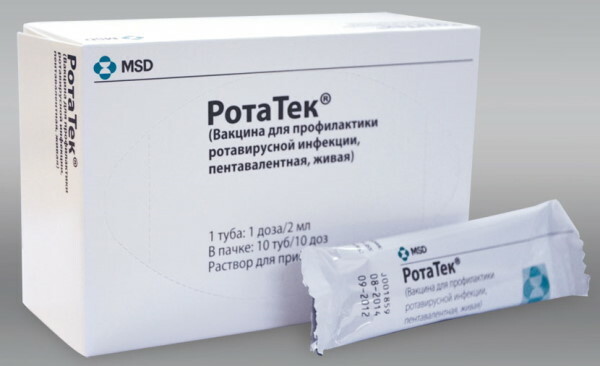
- by 75% contributes to the development in the body of protection against rotavirus infection of any severity;
- Reduces the likelihood of severe infection by 98%;
- Reduces hospital admissions for rotavirus by 96%.
Forecast
Rotavirus in pregnant women in the 1-2-3 trimesters in the absence of symptoms of dehydration passes in a mild form, ensuring the woman's complete recovery on the 5-12th day. Moderate and severe manifestations of the disease, complicated by dehydration of the body, require emergency hospitalization of the expectant mother and carrying out corrective specific treatment aimed at relieving symptoms of intoxication and restoring water-salt balance organism.
Rotavirus infection is an infectious pathology that occurs in the 1st, 2nd or 3rd trimester of pregnancy. The disease that occurs when rotaviruses enter the body causes a fever, repeated vomiting and diarrhea, and in the absence of treatment can cause severe dehydration of the body of the expectant mother and provoke the onset of premature birth or intrauterine death child.
Rotavirus video
Komarovsky about rotavirus:



